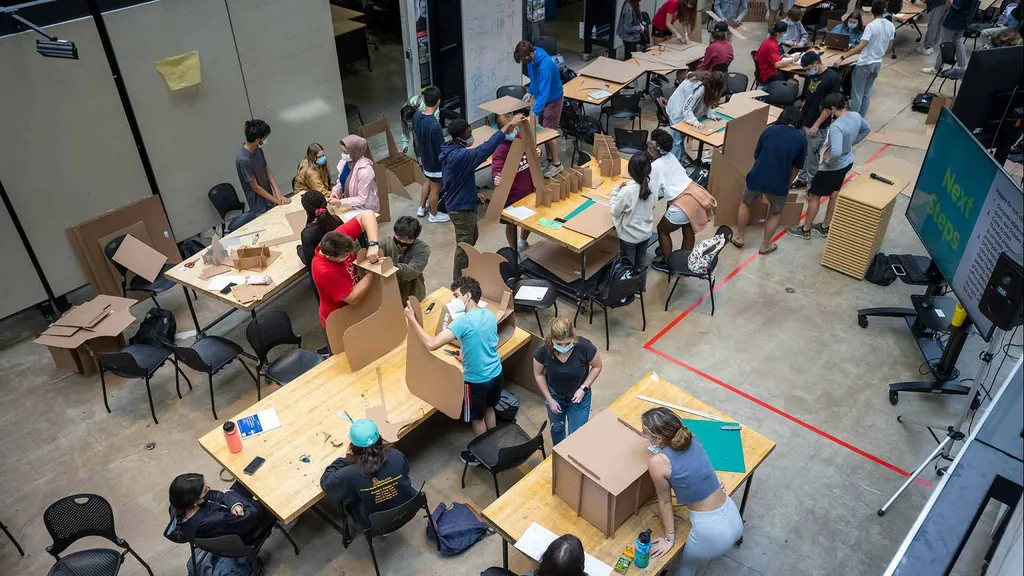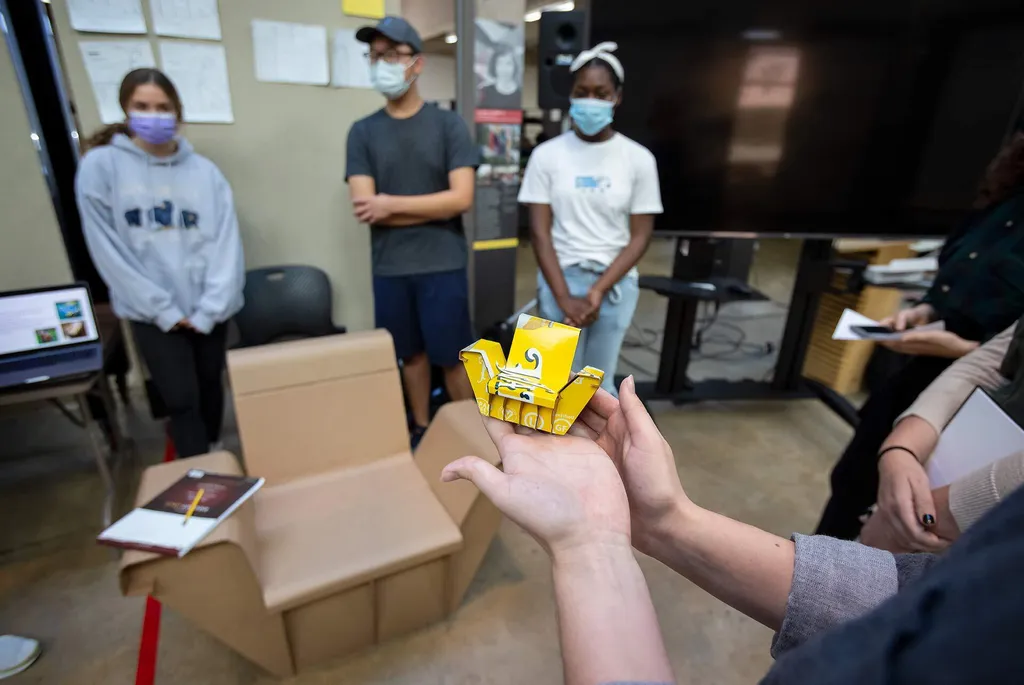- October 22, 2021
- By Annie Krakower
Sophomore Will Lee took a tentative seat in the Architecture Building yesterday, but he didn’t stay down for long—one of his chair’s armrests popped off, prompting him to spring back up to avoid further damage.
But considering it’s a piece of furniture made entirely out of cardboard, being able to sit down at all was considered a victory.
The seating spectacle was part of “Design in Practice,” a course that challenges undergraduates to craft a chair that will hold a person using just six 30-by-40-inch sheets of cardboard, with no glue or fasteners. Throughout the first half of the semester, teams of Terps measured, cut and tested a series of prototypes to prepare for yesterday’s final presentations, when around a dozen architecture graduate students and other volunteers stopped by to take (careful) seats as guest critics for a contest that’s deeply seated in the profession’s basic skills.
“It’s kind of a microcosm of architectural design,” architecture Professor Madlen Simon, who teaches the class, said of the project. “It deals with materials; it deals with connections.”

The chair-building blueprint follows UMD’s Academy of Innovation and Entrepreneurship’s five-step design thinking process—empathize, define, ideate, prototype and test—which Terps across campus use in a variety of disciplines, Simon said.
Empathizing took the form of client interviews, with students trying to determine what classmates wanted in a chair as well as what they’re passionate about. Maybe they’d sit in their chair mostly to do homework, or use it instead for fishing. Insights from those discussions helped teams define design challenges, and sparked ideas ranging from a compact L-shaped seat to a bigger, almost throne-like model and another chair with … fins?
“(Our client’s) favorite animal was a whale,” said Keagan Bergeron ’25. “Whales are pretty fluid, so we could make a rocker and really tap into that fluidity and movement. And we could try to make it look like a whale with the tail.”
Besides just fitting the clients’ interests—aquatic or otherwise—the chairs had to actually function, standing up to vertical, lateral and bending forces, whether from the act of sitting down or shimmying back and forth while seated, or even leaning back.

Groups put their ideas to the test first through miniature handheld prototypes, then with rough, full-scale versions. The process involved “a lot of twists and turns,” Margeret Akande ’25 said last week as her team altered its prototype, crisscrossing several cardboard strips to help better distribute weight. “Our initial design wasn’t like this at all.”
While some prototypes survived the sitter in initial trials—strong examples included one chair with a triangular structure throughout and another that used super-thin strips of cardboard to act as ties—others crumpled to the ground, bringing the testing Terps with them. But to Simon, those flattened fixtures offered just as much educational value.
“I told (the students) whenever there’s a crash, they should all stand up and applaud, and they did,” she said. “Failure is a great learning experience, so you have to celebrate.”
Teams then adapted their designs as needed, leading up to yesterday’s final testing. The guest judges visited each group’s station round-robin style to try out the cardboard creations while students explained their design and construction process.
Besides the occasional buckle or armrest mishap (for the record, armrests were a last-minute visual feature and not essential to the chair’s structure, that team explained), the day went off without any dramatic cardboard crashes.
“When she originally told us we’d be making chairs out of cardboard with no glue or fasteners … I kind of thought it was going to be impossible,” said freshman Lucas Baldwin, whose team’s chair was sturdy and “oddly cozy,” according to the judges. “But it ended up being not that bad. Six sheets of cardboard are essentially holding up my weight.”
